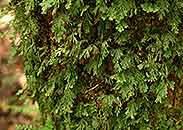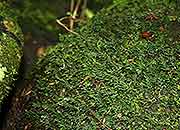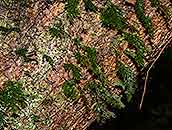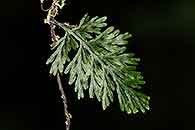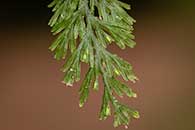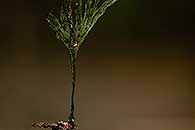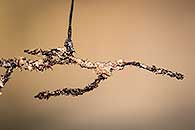Crepidomanes inopinatum (Pic. Serm.) J.P. Roux
Synonyms |
Trichomanes inopinatum (Pic.Serm.) J.E. Burrows |
|---|---|
Common name |
|
Description |
Rhizome less than 0.5 mm in diameter, widely creeping; rhizome hairs very dark brown to dull black, unbranched. Fronds spaced apart. Stipe 5-35 mm long, winged in upper part only, glabrous or set with a few brown, nonarticulated hairs. Lamina variable, 8-75 × 8-30 mm, 2- or 3-pinnatifid; ultimate lobes narrowly oblong, c. 0.7 mm broad, drying fold present. Sori obconical, c. 1.5 × 1 mm, narrowly winged for most of their length, valves rounded, entire. |
Notes | Can be confused with C. melanotrichum: C. melanotrichum has a stipe that is narrowly winged throughout (only in the upper quarter to half in C. inopinatum) and that has black articulated hairs in 2 rows or leftover stubs (absent or few brown in C. inopinatum). The rhizome hairs are shiny black in C. melanotrichum and dark brown to dull black in C. inopinatum. Can be distinguished from
P. borbonicum : P. borbonicum has a stipe that is winged in the distal half to three quarters, has no stipe hairs, the drying fold is absent and rhizome hairs are brown. The sorus is twice as long as wide (as long as wide in C. inopinatum).
|
Derivation | inopinatum: unexpected, it was a surprise to find another species in the genus. |
Habitat | Moist deeply shaded evergreen forest. |
Distribution worldwide | Africa, Madagascar and Mascarene islands. |
Distribution in Africa |
Burundi, Cameroon, Dem. Republic of Congo, Ethiopia, Kenya, Malawi, Rwanda, South Africa, Sudan and South Sudan, Swaziland, Tanzania , Uganda, Zimbabwe. |
Growth form |
Epiphytic, lithophytic. |
Literature |
|
